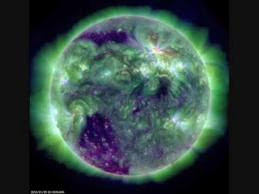A powerful solar eruption has sent a massive stream of charged particles toward Earth – due January 24, 2012. Aurora alert at lower latitudes than normal!
An active region on the sun has spawned an M8.7 eruption – nearly an X-flare – that blasted a stream of charged particles toward Earth, due to arrive on January 24, 2012. Experts at NOAA’s Space Weather Prediction Center are saying it is the strongest radiation storm since 2005. The eruption took place on January 22 at 9:59 pm according to clocks in the central US (03:59 UTC on January 23). There is no danger to Earth’s surface, but satellites in orbit might feel the effects and cell phone might act twitchier than usual.
NASA’s Solar Dynamics Observatory captured the M8.7 flare’s extreme ultraviolet flash. Sunspot 1402 erupted on January 23, 2012 and produced a long-duration M9-class solar flare - nearly an X-flare, the most powerful kind.
The eruption came from sunspot 1402, on a part of the sun that recently turned into view and has been active for several days. The leading edge of the resulting stream of charged particles – known as a coronal mass ejection, or CME – is expected to reach Earth on January 24 at 8 am CST, or 14 UTC (+/- 7 hours). Mars is due to be struck by the CME, too, on January 25.
The curved line in the far left part of this image is the wave of solar radiation particles traveling outward, due to strike Earth on January 24, 2012 and Mars on January 25.
NASA’s Goddard Space Weather Center’s models predict that the CME is moving at almost 1,400 miles per second! Contrast that to Earth’s orbital motion of 18 miles per second. So it is moving fast!
Coronal mass ejections can disrupt radio transmissions and cause damage to satellites in orbit. On very rare occasions, they can affect electrical transmission line facilities, resulting in potentially massive and long-lasting power outages. Humans in space risk exposure to intense radiation.
They are merely the potential effects of such a storm, and these storm happen pretty often especially when the sun is in an active part of its 11-year cycle. In fact, the last CME reported to be headed toward Earth was just a few days ago.
Whatever happens, there is no danger to us on Earth’s surface.
The aurora borealis shines above Bear Lake, Alaska
A powerful solar radiation storm like the one due to strike Earth tomorrow can create particularly beautiful displays of aurorae – known as northern lights (aurora borealis) in the Northern Hemisphere, and southern lights (aurora australis) in the Southern Hemisphere.
It’s not possible to say who will see the aurora on January 24, 2012. But experts are saying that aurorae should be visible at lower latitudes than normal.



















I would like to thank you for the efforts you've put in writing this web site. I'm hoping the same high-grade web site post from you in the upcoming also. In fact your creative writing skills has encouraged me to get my own web site now. Actually the blogging is spreading its wings quickly. Your write up is a great example of it.
ReplyDeleteDormer E009 Powdered Metal Thread Forming Tap, TiN Coated, Round Shank With Square End, Modified Bottoming Chamfer, M16-2.00 Thread Size